What is a Product Line: Definition
The meaning of a product line refers to a group of related products offered by a company under the same brand or category. These products typically share similar characteristics, target the same market segment, and fulfill similar needs or purposes. A product line allows a company to diversify its offerings while maintaining brand consistency and leveraging existing customer relationships.
Companies often manage multiple product lines under different brand names, using factors like price, quality, and target demographics to distinguish them effectively. Expanding existing product lines is a common strategy to capitalize on consumer familiarity with certain brands. However, companies should be ready to phase out unprofitable product lines.
Take, Uniqlo, a popular Japanese clothing retailer, for example, it offers a diverse product line that includes various categories of apparel for men, women, and children. Within its product line, Uniqlo provides a wide range of clothing items such as T-shirts, jeans, dresses, outerwear, and activewear.
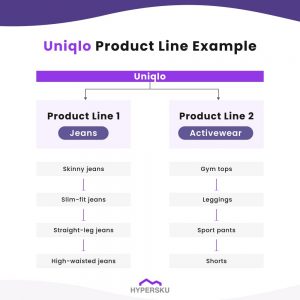
How do Product Lines Work?
Product lines organize similar products under one brand, making it easier for customers to find what they need. When customers are familiar with a brand, they’re more likely to trust it and buy from it again. For example, if someone likes a particular brand of shoes, they may also trust that brand for clothing or accessories.
By grouping products altogether, companies can build on this trust and loyalty, encouraging customers to explore and buy more from their product lines. This helps businesses to attract and retain customers while simplifying their marketing efforts.
Also, Uniqlo extends its product line to include accessories like hats, scarves, and bags. Despite the diversity of products, all items in Uniqlo’s product line share the brand’s emphasis on simplicity, quality, and affordability. This cohesive approach within its produce line allows Uniqlo to cater to different customer preferences while maintaining brand consistency across its offerings.
Types of Product Lines
Product lines are vital for a company’s product portfolio and market position. Knowing the various types helps businesses manage offerings and meet market needs. Here, we explore four key types:
New-to-World
A “new-to-world” product line introduces groundbreaking products never seen before in the market. These innovations address unmet consumer needs or offer unique solutions, requiring significant research and development efforts due to their novelty and inherent risks.
New Additions
“New addition” product lines expand existing offerings with fresh products or variations. They cater to changing consumer preferences, fill gaps in the product range, and capitalize on emerging trends, enhancing customer satisfaction and sales.
Product Revision
“Product revision” lines improve existing products with updates or enhancements. These modifications aim to boost performance, quality, or appeal based on consumer feedback or evolving market demands.
Repositioning
Repositioned” product lines adjust their market positioning to refresh the brand image, target new consumer segments, or seize new market opportunities. Changes in pricing, packaging, or marketing messages realign the product to attract a broader customer base.
What is a Product Line Extension?
A product line extension involves adding new products to attract new customers and expand the existing customer base. This strategy aims to diversify target clients and increase sales by offering a wider range of products.
The extension comes with numerous benefits, let’s take a closer look:
Increased Market Coverage: By offering new products within an existing line, companies can not only attract different customer segments and break into new markets but also cater to more customer preferences and needs, resulting in expanding their reach and revenue potential.
Enhanced Brand Loyalty: Product line extensions make use of existing brand recognition and customer loyalty, encouraging repeat purchases and building stronger relationships with consumers.
Cost Efficiency: Using existing infrastructure, manufacturing processes, and distribution channels reduces the cost of introducing new products. It also saves the costs of product research in the initial stage.
Risk Mitigation: Introducing variations or complementary products minimizes the risk associated with launching entirely new offerings, as they capitalize on the success and familiarity of established brands.
Competitive Advantage: Continuously expanding and innovating within a product line helps companies stay ahead of competitors, differentiate themselves in the market, and maintain relevance among consumers.
Cross-Selling Opportunities: Product line extensions create opportunities for cross-selling and upselling, encouraging customers to explore and purchase additional products within the same brand ecosystem.
Product Line vs. Product Mix
Product lines and product mix are two related concepts in marketing, but they refer to different aspects of a company’s product offerings.
As we said before, product lines are groups of related products that are marketed and sold under a single brand or category. Each product line typically consists of a variety of products that share similar characteristics, target the same market segment, and fulfill similar needs or purposes.
On the other hand, a product mix, also known as a product portfolio, refers to the total set of products that a company offers for sale. Together, all product lines form a company’s product mix, showing the breadth and depth of its offerings in the market. It includes all the different product lines and individual products that the company sells.
Analyzing the product mix helps companies identify market trends and appeal to their target customers, enabling them to restructure underperforming products and innovate within profitable lines. Successful companies typically have diversified product mixes, grown through internal development or geographic expansion, which also leads to a consistent brand image. This expansion allows them to cater to varying preferences across different regions.
By understanding the changes to their product mix, companies can adapt to changing market demands and stay competitive. Now, let’s further explain the four dimensions of product mix:
Breadth/Width
The produce line breadth, also known as product line width, refers to the number of different product lines that a company offers. For example, Nike has a wide product line that includes footwear, apparel, equipment, and accessories.
Depth
The depth represents the variety of products within each product line. Taking Nike’s footwear product line as an example, it offers various types of shoes such as running shoes, basketball shoes, soccer cleats, and lifestyle sneakers, demonstrating a deep product line depth.
Length
The length means the total number of individual products across all product lines. For Nike, its extensive range of shoes, apparel, equipment, and accessories contributes to its long product length, meeting diverse customer needs and preferences.
Consistency
Finally, the consistency reflects how closely related or similar the various product lines are. A business should develop product lines in terms of end use, methods of production, target markets, and price range. In Nike’s case, its product lines share a common theme of athletic performance and lifestyle, maintaining high product consistency.
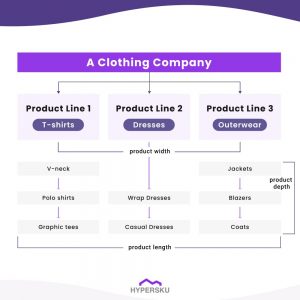
In the example above, we see the product mix consists of a breadth/width of 3, a length of 8, Product Line 1 with a depth of 3, Product Line 2 with a depth of 2, and Product Line 3 with a depth of 3. The mix is considered consistent since all the product lines are apparel-related.
What is Product Line Pricing?
Product line pricing refers to a pricing strategy where a company sets different prices for products within the same product line. Instead of pricing each product individually, companies group similar products together and offer them at different price points based on factors such as features, quality, and potential value.
This strategy allows companies to maximize revenue by appealing to different customer segments with varying price sensitivities. Product line pricing can also help companies position their products in the market, create perceived value, and encourage customers to trade up to higher-priced options.
Let’s look at an example of product line pricing.
Apple typically releases multiple versions of the iPhone each year, such as the base model, the “Pro” model, and the “Pro Max” model. Each model comes with different features, specifications, and price tags.
The base model is usually priced lower, targeting budget-conscious consumers or those who prioritize affordability. In contrast, the “Pro” and “Pro Max” models offer additional features, such as improved camera systems, data storage, larger screens, and enhanced performance, catering to customers willing to pay a premium for advanced functionality and prestige.
This product line pricing strategy allows Apple to maximize revenue by appealing to a broader market spectrum while also leveraging the perceived value of higher-priced models to enhance overall profitability.
Product Line Examples
We have gathered several examples to help you understand product lines better. Learn from these famous companies for insights when developing your product line strategies!
Apple
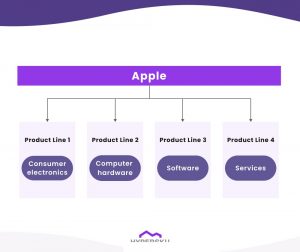
Apple’s product line spans electronic devices and services, including smartphones (iPhone), tablets (iPad), computers (MacBook, iMac), wearables (Apple Watch, AirPods), and services like iCloud and Apple Music.
Renowned for premium quality and sleek design, Apple emphasizes innovation and ecosystem integration. Their strategy fosters brand loyalty by offering complementary products that seamlessly work together, creating a cohesive user experience.
Marketing efforts focus on cutting-edge technology and user-centric design, positioning Apple as a leader in the tech industry.
Starbucks
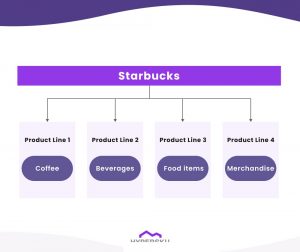
Starbucks offers a diverse product line featuring coffee beverages, teas, pastries, and merchandise, emphasizing premium quality and customization.
Their strategy revolves around innovation, seasonal offerings, and experiential marketing to keep customers engaged and encourage repeat visits. Leveraging brand recognition, Starbucks extends its experience beyond the café with merchandise like mugs and tumblers, fostering brand affinity and serving as effective marketing tools.
Microsoft
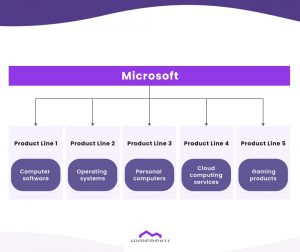
Microsoft offers a diverse product line catering to consumers, businesses, and enterprises, spanning software applications, operating systems, hardware devices, and cloud services.
Their strategy emphasizes product integration, enterprise solutions, and cross-platform compatibility to provide a seamless experience across devices and services. Subscription-based models like Office 365 and Xbox Game Pass ensure recurring revenue streams and foster customer loyalty through regular updates and new features.
Levi’s
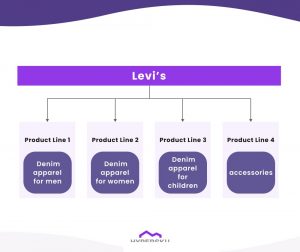
Levi’s product line revolves around denim apparel and accessories for men, women, and children. Primarily known for their iconic denim jeans, Levi’s also offers jackets, shirts, shorts, and accessories like belts and bags.
Their strategy emphasizes product diversification, drawing on their brand heritage and commitment to sustainability. With a wide range of fits, styles, and washes, Levi’s caters to diverse customer preferences while staying relevant through collaborations with celebrities and designers.
While these examples come from major global brands, the same product line strategy applies to eCommerce sellers—whether you run a niche Shopify store or a growing dropshipping business.
Why a Product Line Matters for Your eCommerce Business
A product line isn’t just a collection of items—it’s a strategy. For eCommerce sellers, a strong product line helps:
-
Build brand consistency across your offerings
-
Encourage repeat purchases from loyal customers
-
Streamline inventory, sourcing, and fulfillment
-
Position your store as a niche authority rather than a random mix of products
Think about how brands like Starbucks, UNIQLO, and Levi’s structure their product lines. It’s not about selling everything—it’s about selling with purpose. A well-planned product line can do the same for your online store, whether you’re just starting or looking to scale.
✅ A strategic product line can take you from simply selling products to building a brand that customers remember.
Develop Your Product Line with Help from HyperSKU
Expanding your product line can be a game-changer for your business, offering a myriad of benefits that drive growth and success. By diversifying your offerings, you not only capture a larger share of the market but also cater to diverse customer needs and preferences. A well-curated product line strategy enables you to build brand loyalty, attract new customers, and increase customer lifetime value. However, developing and managing a comprehensive product line requires a reliable and efficient supply chain partner. That’s where HyperSKU comes in.
Partnering with HyperSKU brings unparalleled advantages. With lower MOQs, expert sourcing strategies, and a free-to-use All-In-One Tech platform, you have everything you need to streamline the process and scale your business efficiently. Additionally, benefit from the expertise of an in-house fashion professional and up to 3 dedicated agents for tailored assistance, ensuring that your fashion business thrives in today’s competitive market.
You also can gain access to over 2,000+ rigorously vetted suppliers and manufacturers who provide products designed for maximized returns. Consider us an extension of your back office — we manage sourcing, packaging, and shipping, whether it’s to your warehouse or directly to your customers.
HyperSKU empowers boutiques, brands, and wholesalers to expand product lines with confidence. Knowing that you have a trusted ally supporting your growth journey every step of the way. Experience the power of a streamlined supply chain and unlock the full potential of your business with HyperSKU today!
FAQs About Product Line
What is Product Line Filling?
Product Line Filling involves adding more items to an existing product line to achieve maximum market coverage and meet diverse consumer needs within the target market. For instance, Apple might introduce different storage capacities or color options for its various iPhone models to cater to a wider range of consumer preferences within its product line.
What is a Product Line Decision?
A Product Line Decision refers to the strategic choices made by a company regarding the breadth and depth of its product line, including decisions about adding or removing products.
What is the Difference Between Product Line Extension and Brand Extension?
Product Line Extension involves adding new products to an existing product line under the same brand name, catering to different consumer segments, or expanding into related product categories. Brand Extension, on the other hand, involves using an existing brand name to launch new products in unrelated categories to break into completely new business territories.
Michelin’s brand extension from tires to gourmet guidebooks and related products, driven by the success of its prestigious guides, showcases its expertise and reliability in evaluating quality, establishing trust in the travel and dining industries.
What is Product Line Contraction?
Product Line Contraction involves reducing the number of products within a product line, typically to eliminate underperforming or outdated items, streamline operations, or refocus resources on core or other profitable products.
Related Articles Suggested For You

